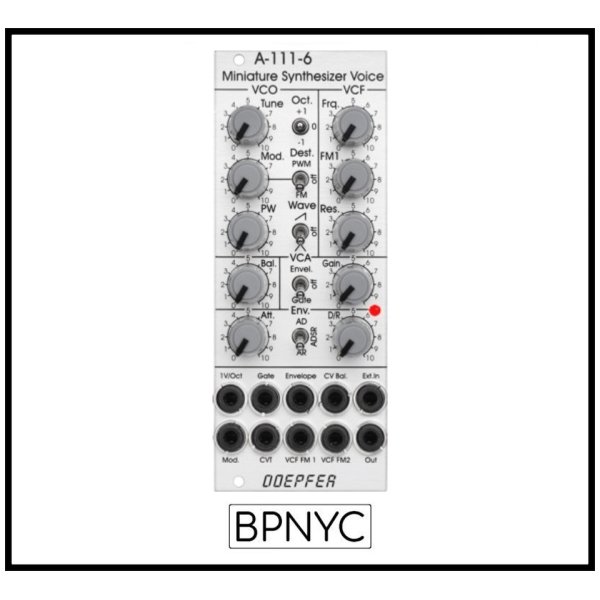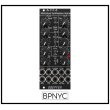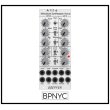商品詳細
Doepfer A-111-6 Miniature Synthesizer 次回入荷分
販売価格: 38,446円
[通常販売価格: 40,900円]
重さ: 1lb
- Tweet
商品詳細
Module A-111-6 is a complete miniature monophonic synthesizer module that has these features available:
(bold = control or socket)
VCO
- triangle core VCO
- frequency range: about 32 Hz ... 16 kHz
- precise 1V/oct tracking: about 32 Hz ... 4 kHz
- Tune: manual tune control (with an internal jumper the range can be set to ~ +/-1 half an octave or ~ +/-2.5 octaves)
- Oct.: range switch -1 / 0 / +1 octave
- Mod.: modulation depth (attenuator wired to the Mod. socket)
- Dest.: switch that is used to address the modulation to frequency modulation (position FM) or pulsewidth modulation (positon PM), in center positon no modulation
- PW: manual pulsewidth control for rectangle waveform, PW can be also modulated by the Mod. input as mentioned above
- Wave: waveform switch (sawtooth / off / triangle), the sum of the waveform chosen by this switch and the rectangle is fed into the VCF (to turn the rectangle off the PW control has to be set fully CCW or fully CW)
- 1V/Oct. (socket): external CV input for VCO frequency (1V/octave)
- access to internal bus CV (via jumper, optional, please remove the bus jumper if this feature is not used to avoid unwanted frequency modulation as then the unused CV line of the bus works as a kind of antenna)
Balance unit
- The balance unit is made of two VCAs which are controlled by the sum of manual Balance control and the balance CV input in the opposite direction.
- The audio input of VCA1 is hard-wired to the VCO output, audio input 2 is connected to the socket Ext.In.
- The output of the balance unit is used as audio input for the VCF
- Bal.: manual balance control, fully CCW the internal VCO is used, fully CW the external signal (Ext.In) is used, at center position both signals have about the same level
- CV Bal.: CV input for balance (range about 0...+5V)
- Ext. In: external audio input for VCA2, about 5 Vpp level required for similar loudness as the internal VCO
- this socket is normalled to the internal VCO suboctave f/2 signal (rectangle with half the frequency), if no external signal is applied the suboctave signal is used as the second signal for the balance unit
VCF
- 24 dB low pass
- Frq.: manual frequency control
- FM1: frequency modulation depth (attenuator wired to the VCF FM1 socket, the socket FM1 is normalled to the internal Envelope signal and then FM1 controls the modulation depth of the internal envelope applied to the filter)
- FM2 (socket) : second CV input for VCF without attenuator (about 1V/octave), the socket FM2 can be normalled to the 1V/Oct socket of the VCO by means of an internal jumper, in this case the VCF frequency follows the VCO frequency (so-called VCF tracking)
- Res.: manual resonance control (up to self oscillation)
- if the VCO is turned off (waveform switch = center position, pulsewidth control = fully CCW or CW) and the VCF resonance is set to maximum the module can be used as a sine oscillator, the tracking at socket VCF FM2 is about 1V/octave (not as precise as the VCO but much better than most other filters)
- ~ 11 octaves frequency range (~ 10 Hz ... 20kHz)
- access to internal bus CV for bus controlled VCF tracking (via jumper, optional, please remove the bus jumper if this feature is not used to avoid unwanted frequency modulation as then the unused CV line of the bus works as a kind of antenna)
VCA
- Gain: manual amplitude control (initial gain), can be used to open the VCA without envelope signal
- VCA (switch): used to switch between gate and envelope as control signal for the VCA, in center position the VCA is not controlled by envelope or gate, in this case the VCA loudness is controlled only by the manual gain control
note: when gate is used the VCA is controlled directly by the gate signal (i.e. hard on/off), this may lead to clicking noise under certan conditions (especially with low VCO/VCF frequencies), an additional jumper is available that adds a bit slew to the gate signal when it is used to control the VCA directly, this avoids the mentioned clicks but lowers the rise and fall time of the gate signal (affects only the internal gate signal processing and has no influence to the applied external gat signal) - special control scale: exponential scale in the range from about -20dB to -80/90dB, linear scale from about -20dB to 0dB
Remark: this special control scale results in a loudness behaviour that is a bit different from pure linear or exponential VCAs - Out: audio output of the module (= VCA output)
Envelope
- Gate (socket): Gate input, level min. +5V/max. +12V, can be normalled to the bus gate signal by means of a jumper
- Att: manual control for Attack
- D/R: manual control for Decay/Release
- Env. (switch): used to switch between A/D, ADSR and A/R mode of the envelope generator, in center position (ADSR) the sustain level is fixed to about 50%
- Envelope (socket): envelope output (about +10V)
- CVT (socket): CV input for time control, by means of two internal jumpers one can select which time parameters are controlled by the CVT input (e.g. A only or D/R only or A/D/R) and in which direction (i.e. if an increasing CVT shortens or stretches the time parameter in question)
- Envelope LED display
- Attack time range: ~ 1ms ... 5 sec (can be extended by using the CVT input)
- Decay/Release time range: ~ 1ms ... 15 sec (can be extended by using the CVT input)
The distances between the controls and sockets are smaller as for the standard A-100 modules and rubberized small-sized knobs are used. In return the front panel has 10 HP width only for a complete synthesizer voice. The module is primarily planned for applications where only limited space is available. The module can be treated as a slimmed version of the A-111-5 synthesizer voice.
The following document shows the positions and functions of the jumpers and trimming potentiometers of the module: A111_6_trimming_potentiometers_and_jumpers.pdf. Pay attention that faulty adjustments caused by the user are not covered by warranty. In this case the working time required to re-establish the correct adjustment has to be charged.
Additional technical information:
The voltage level of the used gate signal has to be at least +5V and the rising/falling slopes has to be fast enough. Otherwise the envelope will be not work in the right way. We discovered that some modules from other manufacturers do not meet these specifications. In this case the level shifter module A-183-4 may help by connecting one unit of the the module between the gate source and the gate input of the A-111-6.
Breite/Width: 10 TE / 10 HP / 50.5 mm
Tiefe/Depth: 50 mm (gemessen ab der Rückseite der Frontplatte / measured from the rear side of the front panel)
Strombedarf/Current: +60 mA (+12V) / -60 mA (-12V)
*** お問い合わせ&予約受付中 ***
当店で扱っている各商品は大量生産ではありません。 メーカーにも在庫に限りがあります...
確実に欲しい商品に関しては早めに予約/在庫確認する事をおすすめします...
尚、お取り寄せをしなければいけない場合の納期は大抵3~5週間位と思っていただければ幸いです。








